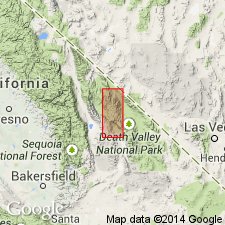
- Usage in publication:
-
- Bee Member*
- Modifications:
-
- Original reference
- Dominant lithology:
-
- Breccia
- AAPG geologic province:
-
- Great Basin province
Summary:
Pg. J5 (fig. 3), J18 (fig. 13), J21, J38-J39. Bee Member of Kearsarge Formation. Megabreccia containing blocks and boulders of quartzite and limestone; = base of Kearsarge Formation (new). Thickness 13.5 m. Unconformably underlies Snowcaps Member (new) of Kearsarge Formation; unconformably overlies Squares Tunnel Formation (new). Present in northwestern-facies belt (base-of-slope and deep basinal environments), notably the Vaughn Gulch area, Inyo County, eastern California. Rocks previously included in Perdido Formation by some geologists. Age is Early Mississippian (late Kinderhookian); Lower CRENULATA zone of Poole and Sandberg (1991).
Type section (=type section of Kearsarge Formation): on ridge on south side of Vaughn Gulch, about 11.5 km east of Independence, west side of Inyo Mountains, [in NW/4 SW/4 sec. 9, T. 13 S., R. 36 E., approx. Lat. 36 deg. 49 min. 00 sec. N., Long. 118 deg. 04 min. 18 sec. W., Bee Springs Canyon 7.5-min quadrangle, 1994 ed.], Inyo Co., eastern CA. Named from Bee Springs in the lower Mazourka Canyon area, Inyo Co., eastern CA.
Source: Publication.
For more information, please contact Nancy Stamm, Geologic Names Committee Secretary.
Asterisk (*) indicates published by U.S. Geological Survey authors.
"No current usage" (†) implies that a name has been abandoned or has fallen into disuse. Former usage and, if known, replacement name given in parentheses ( ).
Slash (/) indicates name conflicts with nomenclatural guidelines (CSN, 1933; ACSN, 1961, 1970; NACSN, 1983, 2005, 2021). May be explained within brackets ([ ]).

